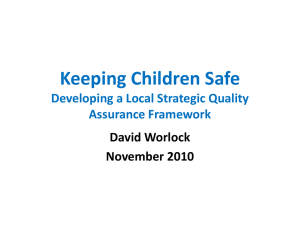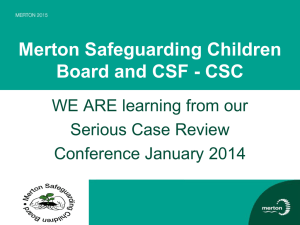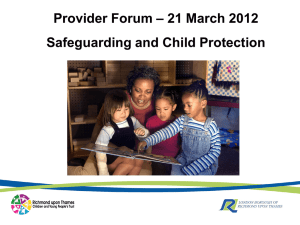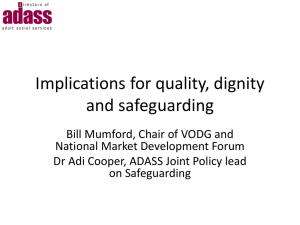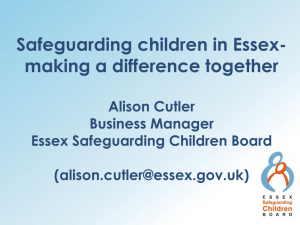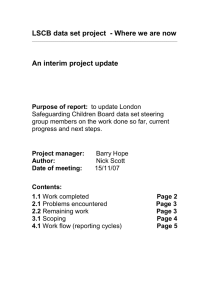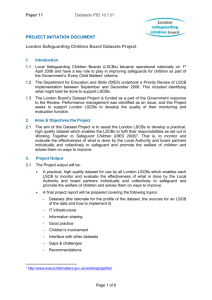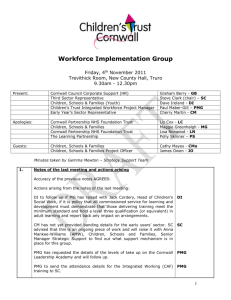BSC Overview - Bradford Safeguarding Children Board
advertisement
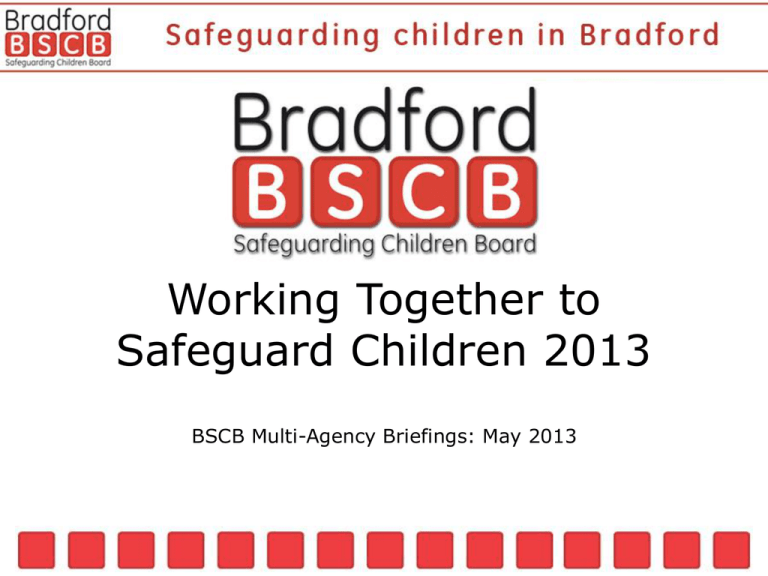
Working Together to Safeguard Children 2013 BSCB Multi-Agency Briefings: May 2013 Welcome • Introduction • Domestics • Outline of briefing • Quiz Aims of this session • To provide an overview of the Guidance. • To give you a chance to test your knowledge. • To focus on key sections: • Assessing & Helping (Chapter 1) • What agencies must do (Chapter2) • Local Safeguarding Children Boards’ organisation, accountabilities and governance (Chapter 3) • Reviewing, learning & improving (Chapters 4 & 5). Overview • The new working together needs to be seen as part of the reforms identified within Professor Eileen Munro’s independent review of the child protection system, and it is consistent with the Government’s “localism” agenda. • It is statutory multi-agency guidance, with a focus on legal requirement. The non-statutory, supplementary guidance documents are removed, although all are listed in appendix C. • It requires local authorities, with their partners, to develop and publish local protocols for assessment, which have been agreed with the LSCB. • The development of sector led professional guidance and local innovation is encouraged. Overview • The principles of “The Framework for the Assessment of Children In Need” (2000) are upheld but in a more succinct and less defined manner. • Effective safeguarding arrangements are underpinned by two key principles. • Safeguarding is everyone’s responsibility. • Safeguarding requires a clear child centred approach. • There is a new definition of safeguarding to include “taking action to enable all children to have the best outcomes”. • You can download a web-enabled version of WTSC 2013 from the BSCB website: http://www.workingtogetheronline.co.uk/chapters/chapter_two.html#sect ion_eleven Assessing need and providing help 1. Providing early help is more effective in promoting the welfare of children than reacting later. 2. Early help assessment should be undertaken by lead professionals who could be e.g. Health visitor, teacher, general practitioner. 3. What ever section of the Children Act 1989 a child is assessed under the purpose of the assessment is always. • Gathering information. • Analysing that information. • Deciding whether the child is in need and what those needs are. • Providing Services. 4. Effective sharing of information between professionals and agencies is essential for effective identification of need and service provision. 5. WTSC 2013 re-emphasises this need. It does not introduce any additional barriers. The Local Authority Assessment Process 1. Assessment should be a dynamic process and should be reviewed on a regular basis. 2. A good assessment is one which looks at the following three domains as a minimum. a. The child’s developmental needs. b. The parents or carers capacity to respond to those needs. c. The impact and influence of the wider family. 3. Every assessment should be focused on outcomes deciding which services and support to provide to improve the child’s welfare The Local Authority Assessment Process 4. The timeliness of an assessment remains a critical element • Within one working day of a referral being received a Local Authority should make a decision about the type of response required. • For children who are in need of immediate protection action must be taken as soon as possible after the referral has been made. • The maximum time frame for an assessment to conclude should be no longer than forty five working days from the point of referral. The Local Authority Assessment Process 5. To assist continuity and consistency there is no longer a requirement to conduct separate initial and core assessments. 6. Social Workers should not wait until the assessment reaches a conclusion before commissioning services to support the child. 7. Social Workers should make clear to families how the assessment will be carried out and when they can expect a decision. Developments in Bradford 1. An early response by Bradford to Professor Munro’s report was the creation of the Integrated Assessment Team. 2. This is a multi-agency assessment team with seconded partners from Health, Police and Education offering consultation to, and referral taking from, professional agencies. 3. This has improved • inter agency communication • professional knowledge and skill sharing • timeliness of response Developments in Bradford 4. In Bradford we are also embarking on work to develop an assessment tool which will. a. Build on our strengths as set out in Ofsted inspections and maintain good timeliness. b. Ensure assessments are proportionate and fit for purpose. c. Ensure assessments are adaptable and can be built upon after the preliminary assessment. d. Ensure the assessment is fit for purpose within public law care proceedings and particularly in context with the family justice review. e. Set out clear timescales and standards of practice to ensure consistency of quality. f. Ensure the assessment process supports and encourages active participation by Children and Young People. g. Ensure that the assessment process promotes active enquiry and challenge to key family members. h. Ensure assessments are rooted in child development and related social work theory, support evidence based practice and good analysis of both need and risk. 5. Bradford, with our partners, and through the LSCB will be developing local protocols for assessment. Any Questions? What Agencies Must Do & Partnership Working Chapter 2 of WTSC reminds agencies of their safeguarding responsibilities under Section 11 of the Children Act 2004 (Education settings have pre-existing, similar responsibilities set out in Sections 157 and 175 of the Education Act 2002). This places duties on a range of organisations and individuals to ensure their functions, and any services that they contract out to others, are discharged having regard to the need to safeguard and promote the welfare of children. Various other statutory duties apply to other specific organisations working with children and families and are set out in this chapter. What Agencies Must Do & Partnership Working • The role of Designated Professionals is emphasised. • All organisations have a responsibility to ensure that appropriate safeguarding competencies are achieved by staff, and that safeguarding children is a mandatory part of induction training. • Allegations management arrangements are in the document, and there is a requirement for all agencies to report to the LADO within 1 working day. Partnership Working: Health • Impact of Health structures and focus on responsibilities of NHS Commissioning Board for safeguarding • Duty to retain expertise locally of named and designated health professionals • Expanded role of CCGs in QA and managing contracts with providers • Role of GPs • Effective mechanisms for LSCBs and HWBs to raise concerns locally • Role of NHS Commissioning Board in leading improvement and ensuring arrangements for LSCB to feedback on local NHS leadership Partnership Working • Greater detail on responsibilities of the police, eg consider effects of DV • Police officers trained in child abuse investigation • Clarification of responsibilities of housing • Probation • YOTs must now have designated safeguarding lead • New sections for faith groups and voluntary and private sectors Local Safeguarding Children Boards Chapter 3 sets out the objectives & functions of LSCBs: 1. Co-ordinate what is done by each person or body represented on the Board for the purpose of safeguarding and promoting the welfare of children in the area; and 2. Ensure the effectiveness of what is done by each such person or body for these purposes. (Section 14 of CA 2004). Local Safeguarding Children Boards • Change in governance to promote independence; • Independent Chair reports direct to CEO; • Explicit requirement for members to share financial responsibility and transparency of budget and expenditure; • Greater detail in annual report; • Business Manager and dedicated support; • Lay Members ( but number not specified). Any Questions? Chapters 4 & 5: Reviewing, Learning & Improving Serious Case Reviews are undertaken to learn and improve services when abuse or neglect of a child is known or suspected; and either : (i) the child has died; or (ii) the child has been seriously harmed and there is cause for concern as to the way in which the authority, their Board partners or other relevant persons have worked together to safeguard the child. Chapters 4 & 5: Reviewing, Learning & Improving Serious Case Reviews: • Must use model consistent with principles in guidance (systems methodology implied); • Emphasis on learning and impact; • National panel of independent experts on SCRs to oversee process and challenge Chairs; • SCRs must be published in full. Chapters 4 & 5: Reviewing, Learning & Improving Other case reviews, audit and challenge: • LSCBs and partners should learn from a range of cases, not just those that meet the criteria for SCRs; • Learning should come from successful cases, as well as those which raise concerns; • Learning should engage front-line practitioners, as well as managers Child Death Reviews LSCBs must review every child death in the District. The LSCB must ensure that there are arrangements in place to ensure that there is a rapid response to sudden & unexpected child deaths. The Child Death Overview Panel (CDOP) must consider whether every death was preventable, or potentially preventable. When appropriate recommendations must be made to improve services. Trends should be identified, lessons collated and an annual report must be published. There is no further central government funding for this activity. Learning and Improvement in Bradford • BSCB has developed a Learning and improvement Framework • Progress Monitored Bi – monthly as a standing item on the BSCB Agenda • Range of reviews , emphasis on learning and improvement reflective practice individuals, organisations • Focus on improvement of outcomes for children in the district Summary: Key Changes • Business as usual! • Core statutory guidance and reduced prescription • Reflects new and developing landscape • More flexible approach to assessment and heightened role of professional judgement and local practice • Change in governance to reflect increased independence of LSCBs • Transparency of Serious Case reviews based on key Munro principles Any Questions? Quiz Answers


